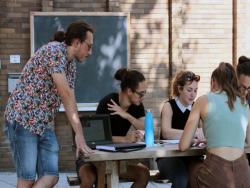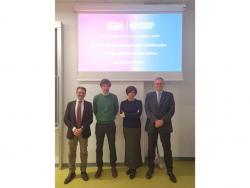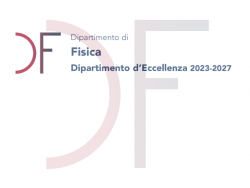Department
History
The research in Physics at the University of Trieste officially began on July 2nd, 1945, with the establishment of the Institute of Physics, which grew and evolved on October 18th, 1984, into the Department of Physics, located at Via Valerio, 2. As stipulated by a specific agreement, this location also hosts the Directorate and some offices and laboratories of the Trieste Section of the National Institute of Nuclear Physics (INFN).
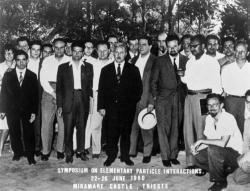 The Department of Theoretical Physics was established on January 1st, 1985. Its headquarters, like that of the Institute of Theoretical Physics from which it originated, has been located in the Miramare building, owned by the University, which also houses the International Centre for Theoretical Physics (ICTP) of UNESCO.
The Department of Theoretical Physics was established on January 1st, 1985. Its headquarters, like that of the Institute of Theoretical Physics from which it originated, has been located in the Miramare building, owned by the University, which also houses the International Centre for Theoretical Physics (ICTP) of UNESCO.
Astronomical research in Trieste has a tradition dating back to the Austro-Hungarian period, with the founding of an Observatory in 1850. The Department of Astronomy, established on January 24th, 1985, from the Institute of Astronomy, was housed in the headquarters of the Trieste Astronomical Observatory (OAT), which later merged into the National Institute of Astrophysics (INAF).
The three departments, with a decade-long experience of scientific and educational collaboration, merged into the new Department of Physics, activated on October 1st, 2009.
The Department of Physics
The Department of Physics (DF) of the University of Trieste was established in 2009 through the merger of the pre-existing departments of Physics, of Theoretical Physics, and of Astronomy (see below). It encompasses the research and training activities of the University of Trieste in the field of physics, specifically in the areas of Astronomy and Astrophysics, Applied Physics, Environmental and Interdisciplinary Physics, Particle and Astroparticle Physics, Condensed Matter Physics, and Theoretical Physics. While it is a medium-sized department, it covers a wide range of research activities and its strength lies in its extensive network of relationships with large local, national, and international research facilities.
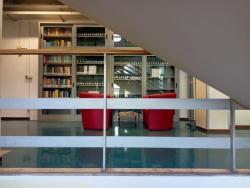 Several members of the DF have held or currently hold significant scientific and managerial responsibilities, both in the governing bodies of research institutions and in international research groups, as well as in the scientific committees of institutions and congresses. This ensures a close connection between DF research and major international trends, both in terms of knowledge sharing and access to cutting-edge research infrastructures. This high-value scientific profile is strongly supported by the solid roots that the DF has in the surrounding territory, particularly in the network of advanced scientific and technological institutions developed with the fundamental contribution of DF physicists and known as the "Trieste System", which has unique characteristics within the Italian and European landscapes.
Several members of the DF have held or currently hold significant scientific and managerial responsibilities, both in the governing bodies of research institutions and in international research groups, as well as in the scientific committees of institutions and congresses. This ensures a close connection between DF research and major international trends, both in terms of knowledge sharing and access to cutting-edge research infrastructures. This high-value scientific profile is strongly supported by the solid roots that the DF has in the surrounding territory, particularly in the network of advanced scientific and technological institutions developed with the fundamental contribution of DF physicists and known as the "Trieste System", which has unique characteristics within the Italian and European landscapes.
The integration within the Trieste System is also highlighted by the three different institutional locations of the DF (at the main campus of UniTS, which also hosts the Trieste section of INFN; at the ICTP headquarters; at the INAF headquarters), as well as by the presence of several of its laboratories in the Area Science Park area (at Elettra, CNR-IOM, CNR-INO, and INFN). This strong connection of the DF with the Trieste System constitutes an optimal condition for attracting faculty and researchers, while simultaneously providing an internationally enriched contribution to teaching and educational offerings.
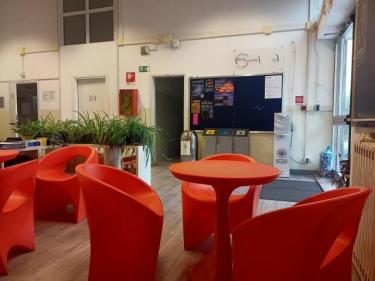 When it comes to advanced education in physics, the DF is engaged at various levels: the three-year Bachelor's Degree Course in Physics, the Inter-University Master's Degree Course in Physics with UniUD (which currently offers five different curricula), and two PhD interdepartmental Courses (in Physics and Nanotechnology). The educational offer also include a two-year Second Level Specialisation Course in Medical Physics, in collaboration with ICTP and accredited by the International Organization for Medical Physics for the advanced training of medical physicists for developing countries.
When it comes to advanced education in physics, the DF is engaged at various levels: the three-year Bachelor's Degree Course in Physics, the Inter-University Master's Degree Course in Physics with UniUD (which currently offers five different curricula), and two PhD interdepartmental Courses (in Physics and Nanotechnology). The educational offer also include a two-year Second Level Specialisation Course in Medical Physics, in collaboration with ICTP and accredited by the International Organization for Medical Physics for the advanced training of medical physicists for developing countries.
Student training also benefits from collaboration with the numerous research institutions in the area, significantly expanding the offering of both lectures and practical exercises, internships, and thesis work in cutting-edge laboratories.
The educational offer of the DF attracts many students, relative to its dimension, who come from a wide geographic area. In particular, enrolments in the Bachelor's Degree program have doubled over the course of a decade, reaching a number comparable to the maximum sustainable threshold, while the Master's Degree program sees the majority of students coming from outside the region.




